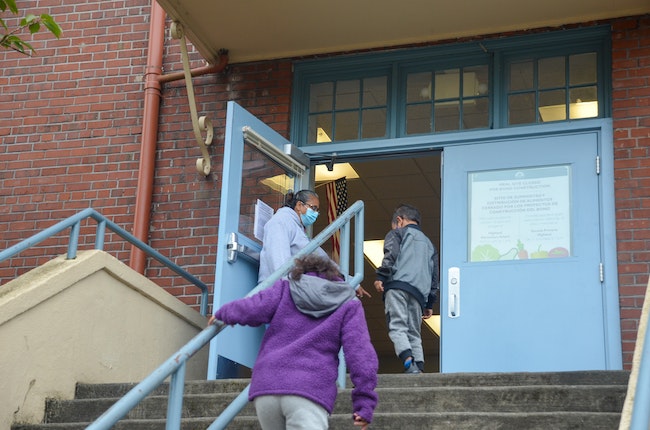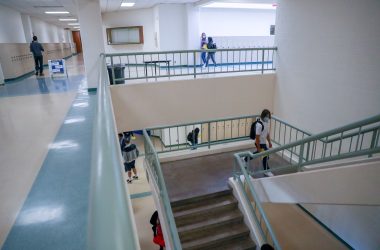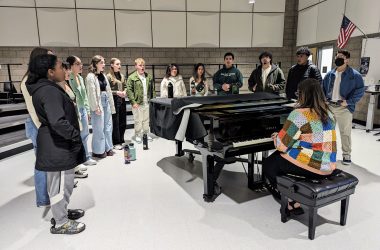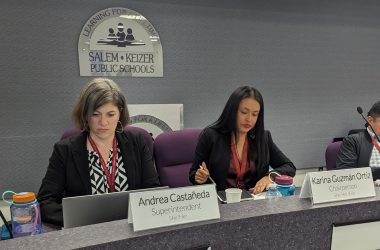
Highland Elementary School students enter the school library for brief in-person classes on Oct. 20, 2020 (Rachel Alexander/Salem Reporter)
Thousands of Salem students who had been getting in-person help with school will be back to virtual class this week, Salem-Keizer Superintendent Christy Perry has announced.
Schools had been bringing students into buildings in small groups to help those who especially struggled with classes because of language barriers, disabilities, home environment or technology issues. This has been in addition to ongoing Internet-based teaching for all students in the district.
Last week, about 4,000 local students spent some time at school – about 10% of the district student body. Next week, that will roll back to about 400, said Assistant Superintendent Kraig Sproles.
Perry’s announcement to district employees came Friday evening after Gov. Kate Brown announced a statewide “freeze” intended to slow a spike in Covid infections. Starting Nov. 18, restaurants and bars are limited to takeout, many other businesses are to close, and social gatherings are reduced to six people.
Schools were not affected by the governor’s decision, but Perry said concerns from the teacher union and Marion County’s rapidly escalating case counts led to her decision. She called it a “no-win” situation and said she hoped pausing now might help drive down local case number enough to allow schools to more fully reopen in the new year.
“It’s breaking our hearts,” she said, noting that district employees who have contacted her are split on whether to keep teaching in-person.
Schools will still be allowed to bring struggling kids in for one-on-one help on a “very limited basis,” Perry told district employees in an email, but more regular classes will end. District employees will be encouraged to work from home, and all sports and in-person extracurricular activities will also stop, she said.
There’s no fixed end date for the school roll back. Sproles said it would depend on local Covid counts and further direction from Brown, but he said it will likely last through the end of the year.
While some smaller and rural Oregon school districts have re-opened schools, most remain closed.
Among Oregon’s largest school districts, Salem-Keizer was unusual in offering regular in-person sessions, Oregon Department of Education data shows. Districts including Portland, Beaverton, Tigard-Tualatin and David Douglas reported virtually no students attending in-person sessions the week of Nov. 1, while Hillsboro reported just a handful at some schools.
State school guidelines suggest districts “consider pausing” small in-person sessions when local Covid case counts rise above 200 cases per 100,000 county residents over two weeks. In Marion County, that figure was 358 cases per 100,000 residents for the two-week period ending Nov. 14, up from 281 per 100,000 the two weeks prior, according to the Oregon Health Authority.
Mindy Merritt, president of the Salem-Keizer Education Association, agreed teachers are divided about working in person, and all understand that online learning isn’t working well for some students.
“This is excruciating because absolutely every day our members, as teachers, we are witnessing and experiencing students that we are not quite able to connect with, that are not turning on their computers,” she said.
She said many teachers who are working from home are doing so because they’re personally at high risk for Covid or live with someone who is.
“It’s not because they’re not caring, it’s because they also have to take care of themselves,” she said.
The association had supported the slow rollout of more regular in-person sessions for kids struggling online, something Perry said she was grateful for as other large districts kept doors closed.
The district began the school year with some one-on-one sessions for kids inside school buildings. Those included kindergarten orientations where students met their teachers face-to-face before seeing them on Zoom, as well as assessments for special education and English proficiency that can’t easily be done online.
By mid-October, a handful of district schools were holding near-daily classroom sessions for kids who couldn’t effectively attend class online, meeting in groups of 10 for two hours per day – the maximum allowed by state guidelines. At the time, administrators said the goal was to expand that approach to all schools by mid-November.
Merritt praised administrators at Highland Elementary School for working with educators to establish safety protocols.
On Oct. 30, Brown announced relaxed school reopening metrics intended to get more kids back in the classroom. The revised rules did allow more kids to come in for limited sessions in-person, increasing the size of a group from 10 students to 20 and removing a cap that had allowed no more than 250 students total in a building in one week.
Merrit said she and many members grew concerned about the scale and speed of the rollout as local Covid cases continued to climb.
“Before we could really see what the outcome was, we started seeing schools who were moving very quickly and were starting to implement (limited in-person instruction) … and we were going to start having much larger groups more frequently,” she said.
For the first time last week, Oregon Health Authority recorded scattered cases of Covid in some Salem-Keizer schools that were providing face-to-face instruction Those included two students at South Salem High School, one employee at McNary High School, two employees at North Salem High School and one employee at Hallman Elementary School, according to the Nov. 12 report. About 40 district schools have been open for in-person classes.
Cases are disclosed at any school where employees or students who have been in the building test positive for the virus. The listing of a school doesn’t necessarily mean Covid spread between people inside the building. When a case is reported at a school, the district works with the local health department to identify students and employees in close contact.
But Merritt said those cases as well as the county’s climbing rate raised the union’s worries about continuing the in-person classes. She said she appreciated Perry listening to their concerns.
“It’s not worth anyone getting sick,” she said.
Contact reporter Rachel Alexander: [email protected] or 503-575-1241.
SUPPORT ESSENTIAL REPORTING FOR SALEM – A subscription starts at $5 a month for around-the-clock access to stories and email alerts sent directly to you. Your support matters. Go HERE.

Rachel Alexander is Salem Reporter’s managing editor. She joined Salem Reporter when it was founded in 2018 and covers city news, education, nonprofits and a little bit of everything else. She’s been a journalist in Oregon and Washington for a decade. Outside of work, she’s a skater and board member with Salem’s Cherry City Roller Derby and can often be found with her nose buried in a book.









